Week 1
Welcome to the fifth course of your Level 3 Certificate in Electrical Pre-Trade. Congratulations – you have passed the halfway point!
You will begin by learning about various circuit protection devices and their mode of operation. The face-to-face sessions provide opportunities to handle these devices.
Moving on, you will be introduced to architectural plans – site plans, floor plans, elevations, details, electrical plans, structural plans, and landscaping plans. There are a lot of different plans involved in any construction and installation! You will also need to understand legends, keys, specifications, symbols and scale.
Earlier in the programme you practised circuit drawing. Course Five introduces other types of electrical drawings - block diagrams, circuit diagrams, symbols, wiring diagrams, ladder diagrams. You will also have the opportunity to use CAD software to create drawings.
The final section of course 5 looks at low voltage switching circuits. You will learn about the different types of switches available and different wiring systems for lighting circuits. Your knowledge of circuit protection and electrical drawings will assist you in the design and construction of lighting circuits.
During the face-to-face sessions of Course Five you will continue learning about and constructing circuits with your tutor. Your workshop practice should continue to be guided by the relevant NZ legislation, namely AS/NZS 3000:2018. You should be feeling quite familiar with the Wiring Rules now.
This online self-paced resource contains daily ‘lessons’ as well as self-directed learning (SDL). The SDL reinforces and clarifies what you cover in the lessons, plus it helps you to prepare for the assessments. Make sure you commit to putting in the extra hours required – the final result will be worth it.
With the support of your Tutor, you’ll review your work, and receive feedback towards set development and performance objectives.
| Day One | Day Two | Day Three | Day Four | |
|---|---|---|---|---|
| Course Content | Circuit protection: Over-current; Earth leakage; and Surge protection devices. | Circuit Breakers & MCBs – construction, operation, ratings, applications. | Fuses – construction, operation, ratings, applications. | RCDs – construction, operation, ratings, applications. |
| Self-directed Learning | Review exercise |
New build scenario - choosing protective devices. | Comparison of MCBs and fuses. | 10 most important points about RCDs for NZ residential situations. |
In order for you to gain the most value from your qualification and to prepare you for your assessment and the industry, make sure you complete all of the online and SDL tasks.

What we're covering:
- devices that protect electrical circuits
For every electrical installation, it is necessary to ensure the safety of personnel as well as the protection of equipment from electrical faults. All electrical wiring systems and all electrical apparatus associated with wiring must be protected to:
- Prevent damage by fire or shock.
- Maintain continuity of the supply.
- Disconnect faulty apparatus from the remainder of the system.
- Prevent damage to wiring and equipment.
- Minimise the system interruptions under fault conditions.
There are several types of devices that protect electrical circuits from various types of electrical faults. These devices can be categorised based on their mode of action or how they operate to protect the circuit. The three main categories of circuit protection devices are as follows:
Overcurrent Protection Devices
Overcurrent protection devices are designed to protect electrical circuits from damage caused by excessive current flow. These devices operate by interrupting the circuit when the current flow exceeds a predetermined level. Overcurrent protection devices can be further categorised into the following types:
- Circuit Breakers: Circuit breakers are devices that operate by tripping a switch to open the circuit when the current flow exceeds a predetermined level. Circuit breakers are classified based on their construction and rated current, such as miniature circuit breakers (MCBs), moulded case circuit breakers, and air circuit breakers.
- Fuses: Fuses are devices that consist of a thin wire or filament that melts when the current flow exceeds the rated value, thereby interrupting the circuit. Fuses are classified based on their construction, such as semi-enclosed rewireable fuses, cartridge fuses, and HRC fuses.
Earth Leakage Protection Devices
Earth leakage protection devices are designed to protect against electrical shock hazards caused by current leakage to earth. These devices operate by monitoring the difference between the current flowing in the live (hot) conductor and the neutral conductor. Earth leakage protection devices can be further categorised into the following types:
- Residual Current Devices (RCDs): RCDs are devices that operate by detecting any current leakage to earth and quickly disconnecting the circuit, thereby protecting the person from electric shock.
- Ground Fault Circuit Interrupters (GFCIs): GFCIs are similar to RCDs, and they operate by monitoring the difference between the current flowing in the live and neutral conductors of a circuit. If the current flowing through the live conductor is not equal to that flowing through the neutral conductor, the device will trip, thereby disconnecting the circuit.
Surge Protection Devices
Surge protection devices are designed to protect sensitive electrical equipment against damage caused by power surges and spikes. These devices operate by limiting the voltage and current levels during momentary overvoltage. Surge protection devices can be further categorised into the following types:
- Surge Arresters: Surge arresters are devices that divert overvoltage surges to earth, thereby protecting the electrical equipment from damage.
- Surge Suppressors: Surge suppressors are devices that limit the voltage level of momentary overvoltage and protect the electrical equipment from damage.
- Surge Protectors: Surge protectors are devices that combine both surge arresters and suppressors to provide comprehensive protection against momentary overvoltage.
Note - Isolators are not typically considered as circuit protection devices, however they are an important component of electrical installations and are often used in conjunction with circuit protection devices to ensure the safety and reliability of electrical systems. They are used to isolate an electrical circuit or equipment from the power source to allow for safe maintenance or repair work. Isolators can be manual or motorized and are commonly used in switchboards, distribution boards, and other electrical installations to provide a means of isolation.
Exercise 1
Exercise 2
Find an image of each device and add it to the appropriate place in the table in this worksheet.
Self-directed Learning
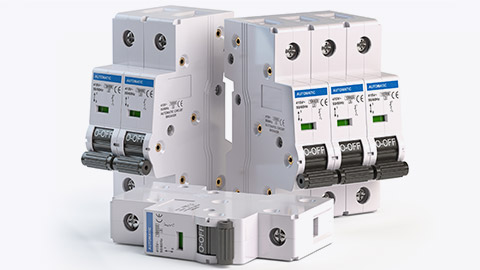
What we're covering:
- purpose of circuit breakers
- mini circuit breakers
Circuit breakers are designed to automatically break an electrical circuit when an overload or a short circuit is detected. This is done using an electromechanical or electronic mechanism that detects the excess current and triggers the breaking of the circuit. Circuit breakers are intended to be reused after they are “tripped”.
- Construction: Circuit breakers are constructed with three main components: contacts, an operating mechanism, and a trip unit. The contacts are made of a conductive material and are designed to open and close the circuit. The operating mechanism is responsible for controlling the opening and closing of the contacts. The trip unit is responsible for detecting over-currents and short circuits and tripping the circuit breaker to interrupt the current flow.
- Operating principles: Circuit breakers operate on the principle of electromechanical or electronic trip units that sense current levels in the circuit. When the current exceeds the rated value, the trip unit sends a signal to the operating mechanism, which opens the contacts to interrupt the current flow. Circuit breakers may be designed to trip either thermally or magnetically, depending on the nature of the fault current.
- Typical ratings: Circuit breakers are rated according to their maximum operating voltage, rated current, and short circuit current. Common ratings for circuit breakers in NZ include 230VAC to 415VAC for voltage, 6A to 2,000A for current, and 10kA to 200kA for short circuit current.
- Applications: Circuit breakers are used in a wide range of applications to protect electrical systems and equipment from over currents and short circuits. They may be used in residential, commercial, and industrial settings to protect lighting, power, and control circuits, as well as equipment such as motors, transformers, and generators. Circuit breakers are also used in switchgear and distribution panels to provide protection and control for complex electrical systems. Some common applications of circuit breakers include air conditioning systems, elevators, pumps, and lighting circuits.
Miniature Circuit Breakers (MCBs)
Similar to a circuit breaker, an MCB will trip and break the circuit when the current exceeds a certain level. However, unlike a circuit breaker, an MCB is designed to protect a specific circuit or appliance, rather than the entire electrical system. It is typically installed in a distribution board or consumer unit. MCBs differ from traditional circuit breakers in their construction, size, and operating characteristics.
- Construction: MCBs are compact and designed to fit into standard electrical panel boards. They typically consist of an electromechanical trip unit and a thermal-magnetic overcurrent protection mechanism. The trip unit is activated by an electromagnetic coil or bimetallic strip when an overcurrent is detected, causing the circuit to be interrupted.
- Operating principles: MCBs operate on the principle of thermal-magnetic protection. The thermal protection element detects and responds to overloads, while the magnetic protection element detects and responds to short circuits. The trip unit is calibrated to respond to a specific overcurrent level, providing precise protection for the electrical circuit.
- Typical ratings: MCBs are rated based on their current-carrying capacity and breaking capacity. In New Zealand, MCBs are typically available with current ratings ranging from 1A -125A, and voltage ratings ranging from 240V - 415V.
- Applications: MCBs are widely used to protect residential, commercial, and industrial electrical circuits. They are commonly used in lighting, power, and control circuits, as well as motors, transformers, and other equipment. MCBs are also used in combination with other protection devices such as surge protectors and ground fault circuit interrupters (GFCIs) to provide more comprehensive protection for electrical systems.
MCBs are smaller and more compact than traditional circuit breakers, making them easier to install in standard electrical panel boards. They are designed to provide more precise protection for electrical circuits, with calibrated trip units that respond to specific overcurrent levels. They tend to be cheaper than traditional circuit breakers.
"How Circuit Breakers Work" by The Engineering Mindset - This video provides a detailed explanation of how circuit breakers work and includes animations to help visualise the process.
Exercise 3
Refer to the diagrams in each case to answer the questions on this worksheet:
Self-directed Learning
Scenario: A homeowner is planning to install a new electrical system in their home and needs to choose between a circuit breaker and a miniature circuit breaker as the protective device for each circuit. As an electrical engineer, you are tasked with advising the homeowner on the best protective device for their electrical system.
Considerations:
- The electrical system will have multiple circuits with different loads and voltages.
- The homeowner wants a protective device that is reliable, efficient, and cost-effective.
- The electrical system will be used for both residential and commercial purposes.
Answer the following questions to assist with your advice the homeowner, then email your answers to your tutor.
- What are the main differences between circuit breakers and miniature circuit breakers?
- What are the advantages and disadvantages of each type of protective device?
- How do the load and voltage of each circuit impact the choice of protective device?
- What are the safety considerations when choosing a protective device for an electrical system?
- What will you suggest to the homeowner?
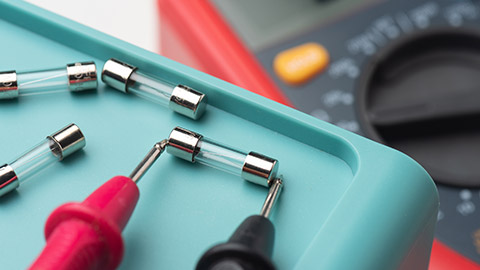
What we're covering:
- properties of fuses
- types of fuses
According to the New Zealand Wiring Rules, a fuse is a "device that is intended to open the circuit by fusing one or more of its specially designed and proportioned components when the current exceeds a given value for a sufficient time."
In other words, a fuse is a device that breaks an electrical circuit when it detects an overload or a short circuit. It contains a metal wire that melts and breaks the circuit when the current exceeds a certain level. The size and type of wire that is used in the fuse will dictate how much current can pass through that individual fuse. This is a one-time operation, and the fuse will need to be replaced before the circuit can be restored.
Fuses come in various sizes and ratings and are designed to protect electrical circuits and equipment from damage caused by overcurrent conditions, such as short circuits and overloads. When a fuse blows, it must be replaced with a new fuse of the same size and rating to ensure continued protection.

- Construction: Fuses consist of a fuse element, which is typically a wire or filament made of a metal such as copper or silver, enclosed in a protective housing. The housing is usually made of glass or ceramic to provide electrical insulation and mechanical protection.
- Operating principles: When an overcurrent or short circuit occurs, the current flowing through the fuse element causes it to heat up and melt, breaking the circuit and interrupting the current flow. The size and type of fuse element is selected based on the current rating of the circuit being protected, and the time-current characteristics of the fuse are designed to provide the appropriate level of protection.
- Typical ratings: Fuses are rated based on their current-carrying capacity, voltage rating, and breaking capacity. In New Zealand, fuses are typically available with current ratings ranging from a few milliamps to several thousand amps, and voltage ratings ranging from a few volts to several hundred volts.
- Applications: Fuses are used in a wide range of applications, including residential, commercial, and industrial settings. They are commonly used to protect lighting, power, and control circuits, as well as equipment such as motors, transformers, and generators. Fuses can also be used in combination with other protection devices such as circuit breakers, to provide more precise protection and reduce the risk of equipment damage and downtime.
Watch the Circuit Breakers and Fuses Explanation.
There are several types of fuses you are likely to encounter during your career:
Semi-Enclosed Wirable Fuses
This type of electrical fuse was commonly used in electrical installations in the past. It consists of a rectangular ceramic base with two or more terminals, which holds a replaceable fuse wire. The fuse wire is stretched between two terminals and clamped in place. The body of the fuse is typically open at one end, allowing the user to replace the fuse wire when it blows.
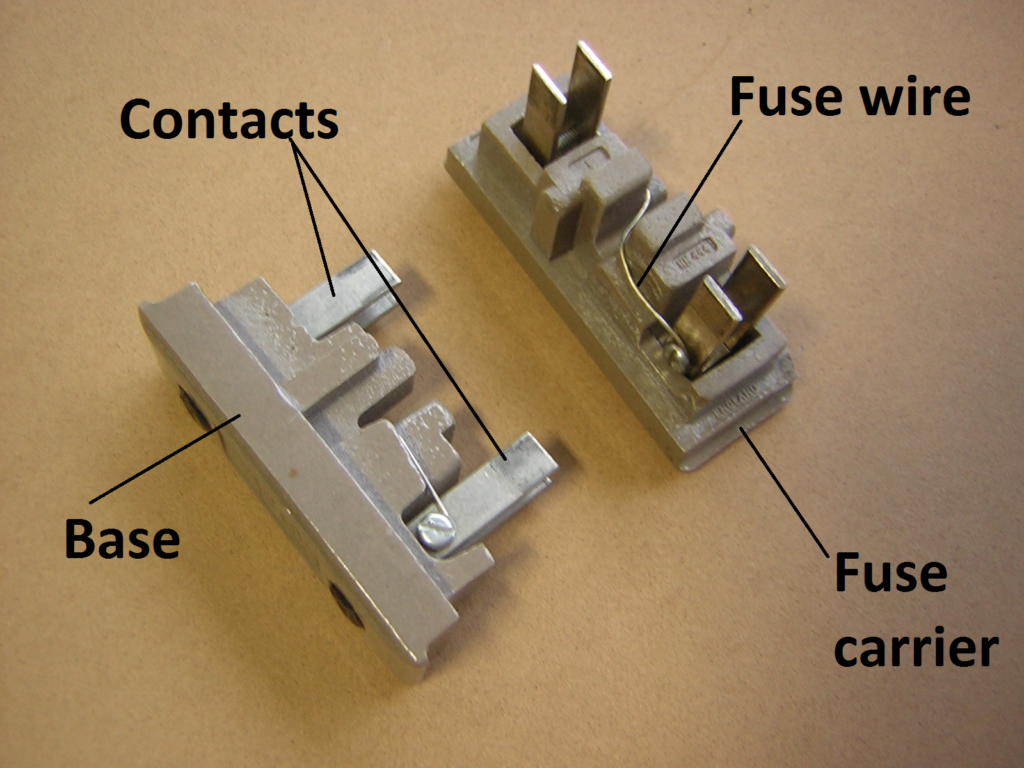
Sometimes referred to as a "Kit-Kat" fuse, since its shape resembles the chocolate bar, semi-enclosed rewireable fuses are becoming less common in modern electrical installations due to some limitations and disadvantages, including:
- Safety concerns: Fuses can expose the user to live parts and present a risk of electric shock. Arc flashes or fires may also occur when the fuse wire blows.
- Limited performance: Fuses have limited ability to interrupt short-circuit currents and may not provide reliable protection against overloads or earth faults.
- Inconvenient maintenance: Replacing the fuse wire requires manual intervention and can be time-consuming and inconvenient.
- Availability: Availability of the correct type and rating of replacement fuse wire can be limited.
Semi-enclosed rewireable fuses may still be used in certain applications, such as in older equipment or situations where replacement fuses need to be readily available.
Cartridge Fuses
This type of fuse consists of a cylindrical body made of ceramic or glass, which contains a wire or filament that melts when exposed to excessive current flow. When the current flow exceeds the rated value, the wire or filament heats up and melts, breaking the electrical circuit and preventing further damage to the equipment or circuit. Cartridge fuses are available in various sizes and ratings and can be used for a range of applications, from low-voltage electronic circuits to high-voltage power systems.
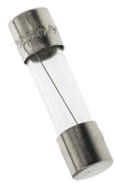
High Rupturing Capacity (HRC) Fuses
HRC fuses are a type of cartridge fuse that have a high rupturing capacity, which means they can interrupt high fault currents without exploding or causing damage. This type of fuse has a ceramic body and contains a fuse element made of silver or copper. They are commonly used in industrial and commercial applications where high levels of fault current is present, such as in power distribution systems and motor control centres.
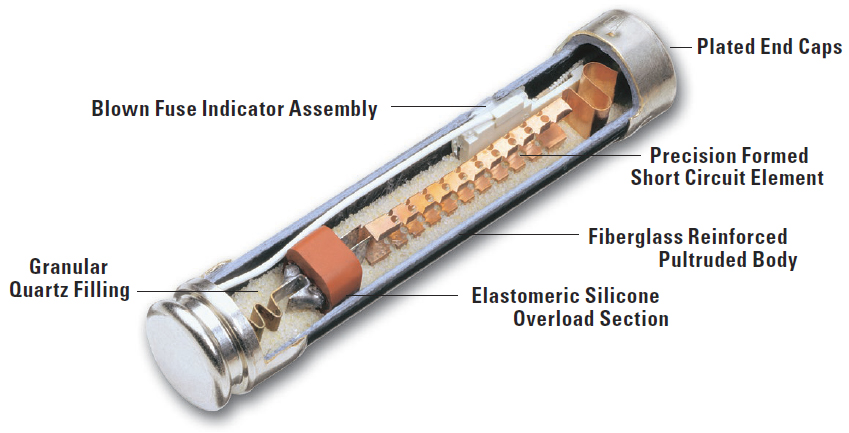
Watch the video showing what is inside an HRC fuse.
You may come across other types of fuses, including:
- Plug fuse: Used in older electrical installations to protect individual electrical outlets.
- Thermal fuse: Uses a thermal element to open the circuit when it overheats due to excessive current or temperature.
- Semiconductor fuse: Designed to protect electronic devices from overcurrent conditions. It contains a semiconductor element that melts when current levels exceed a certain threshold.
- Resettable fuse: Also known as a polyfuse or PTC (positive temperature coefficient) fuse, that can reset itself after a fault condition is cleared, making it suitable for applications where frequent overcurrent events occur.
- High-voltage fuse: Designed to protect high-voltage electrical systems from overcurrent conditions. They can handle high voltage and current levels.
The specific type of fuse used in an application depends on factors such as the voltage and current levels, the type of equipment being protected, and the required performance characteristics.
AS/NZS 3000:2018 provides guidelines and requirements for the installation of fuses and other electrical components. Consider the following when installing fuses:
- Fuse Rating: The fuse rating must be selected based on the expected current load and the protection requirements of the circuit. It is essential to ensure that the fuse's rating is not higher than the maximum current-carrying capacity of the wiring, as this can create a fire hazard. The fuse rating must also be selected to provide adequate protection against overcurrent and short-circuit faults.
- Fuse Type: The fuse type must be suitable for the application and installed in a manner that prevents damage to the fuse and the surrounding equipment. For example, if the circuit requires protection against earth leakage currents, a residual current device (RCD) must be installed instead of a standard fuse.
- Fuse Location: The fuse must be easily accessible and installed in a manner that prevents damage and minimises the risk of electrical shock. The fuse must also be located as close as possible to the source of power, to reduce the risk of damage to downstream equipment in the event of a fault.
- Fuse Replacement: Any replacement fuse must have the same rating and type as the original fuse. It is also essential to ensure that the replacement fuse is suitable for the application and is installed correctly.
Fuse Boards
You may have come across a fuse board in an older electrical installation. Fuse boards contain several semi-enclosed rewireable fuses or cartridge fuses, that protect different circuits in the building. Each circuit is connected to a separate fuse that will blow if the current exceeds the rated value of the fuse. Fuse boards have been largely replaced by modern consumer units or distribution boards, containing MCBs and RCDs.
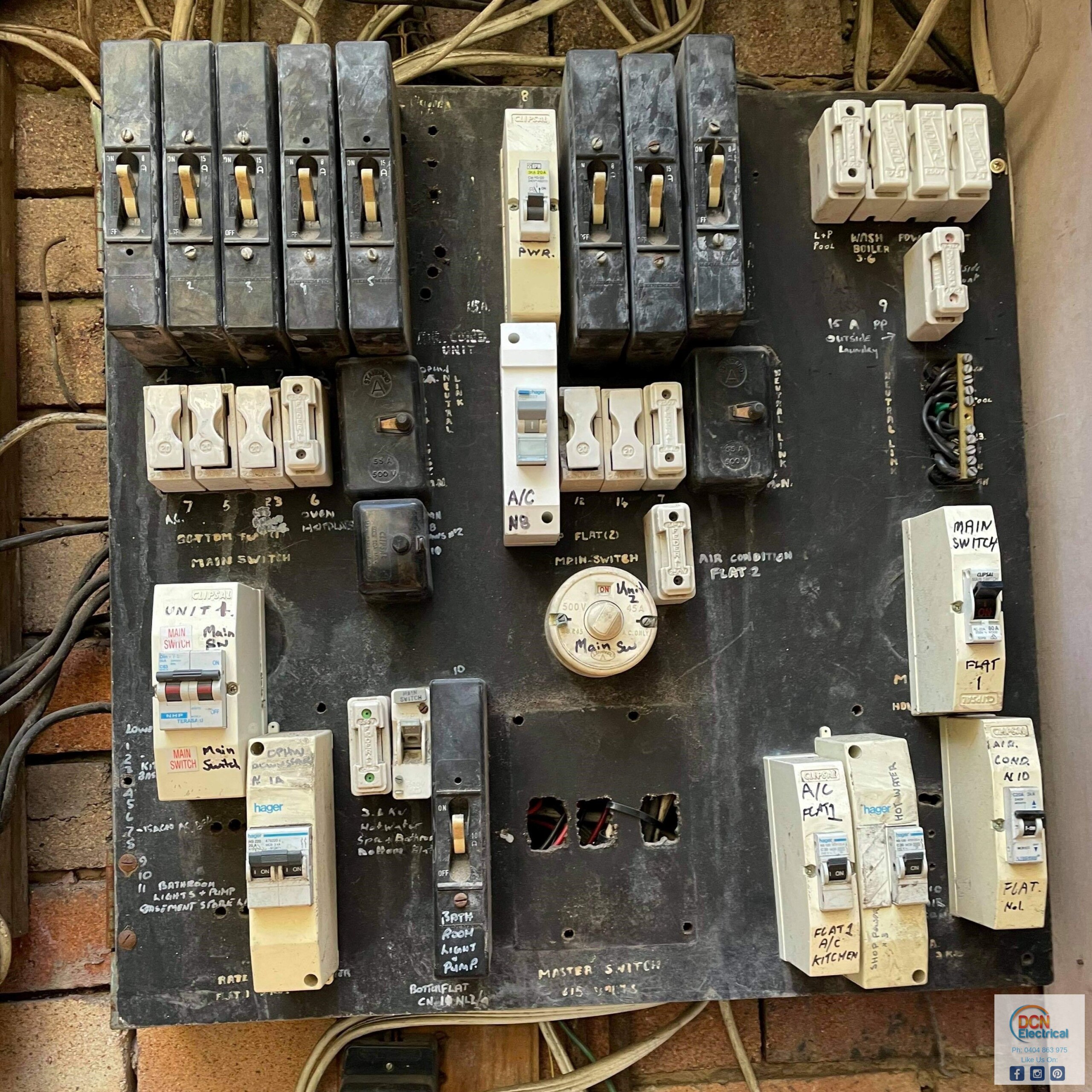
Exercise 4
Answer the questions on this worksheet about fuses. Alternatively, you can complete the activity below.
Self-directed Learning
Answer the questions on the worksheet you downloaded for Exercise 4 above.
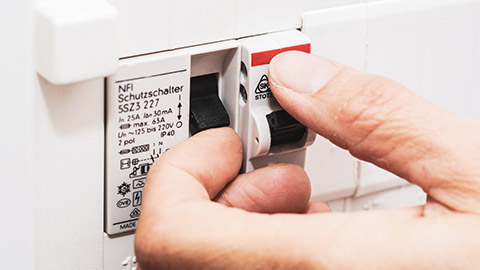
What we're covering:
- components of RCDs
- uses of RCDs
An RCD is a safety device used to protect against electrical shock by interrupting the flow of electricity in the event of a ground fault. Also known as a safety switch, an RCD works by constantly monitoring the electric current flowing through a circuit. If it detects an imbalance in the current, which may indicate that electricity is flowing through a person instead of the intended path, it will quickly cut off the power supply to that circuit. RCDs are commonly used in homes, businesses, and industrial settings to help prevent electrocution and other electrical hazards.
- Construction: RCDs are made up of several components including a transformer, a sensing circuit, and a switching mechanism. The transformer works to create a magnetic field, which is then used to sense any current imbalance between the live and neutral conductors. If a current imbalance is detected, the switching mechanism will quickly interrupt the flow of electricity to prevent electrical shock.
- Operating Principles: RCDs operate on the principle of detecting a difference between the current flowing through the live and neutral conductors. This can occur when a person touches a live conductor or when there is a fault in an appliance or wiring that causes current to flow to earth. When this happens, the RCD will detect the imbalance and quickly disconnect the circuit, preventing electrical shock.
- Typical Ratings: In New Zealand, RCDs are typically rated between 10mA and 30mA. A rating of 10mA is common in areas where people are at higher risk of electrical shock, such as bathrooms, kitchens, and outdoor areas. A rating of 30mA is commonly used in other areas of a building where the risk of electrical shock is lower.
- Applications: RCDs are commonly used in a variety of applications, including homes, businesses, and industrial settings. In New Zealand, it is mandatory to have RCDs installed in new homes and any alterations or additions to existing homes must also have RCD protection installed. They are required by law to be installed in certain areas of a home, such as bathrooms, kitchens, and outdoor areas. It is recommended that portable RCDs be used for any outdoor electrical equipment, such as power tools or outdoor lighting, to provide additional protection against electric shock. In addition, RCDs are commonly used in commercial and industrial settings to provide protection against electrical hazards. They are often used in conjunction with other safety devices, such as circuit breakers and surge protectors, to provide a comprehensive safety solution.
Watch these videos explaining how RCDs work.
Exercise 5
Self-directed Learning
Task: You have been hired as an electrician to install RCDs in a newly constructed residential building in New Zealand. In order to ensure proper installation and usage of RCDs, summarise the ten most important points about RCDs in Clause 2.6 of the NZ/AS 3000:2018 Wiring Rules for NZ residential situations. Email your tutor with your summary.
